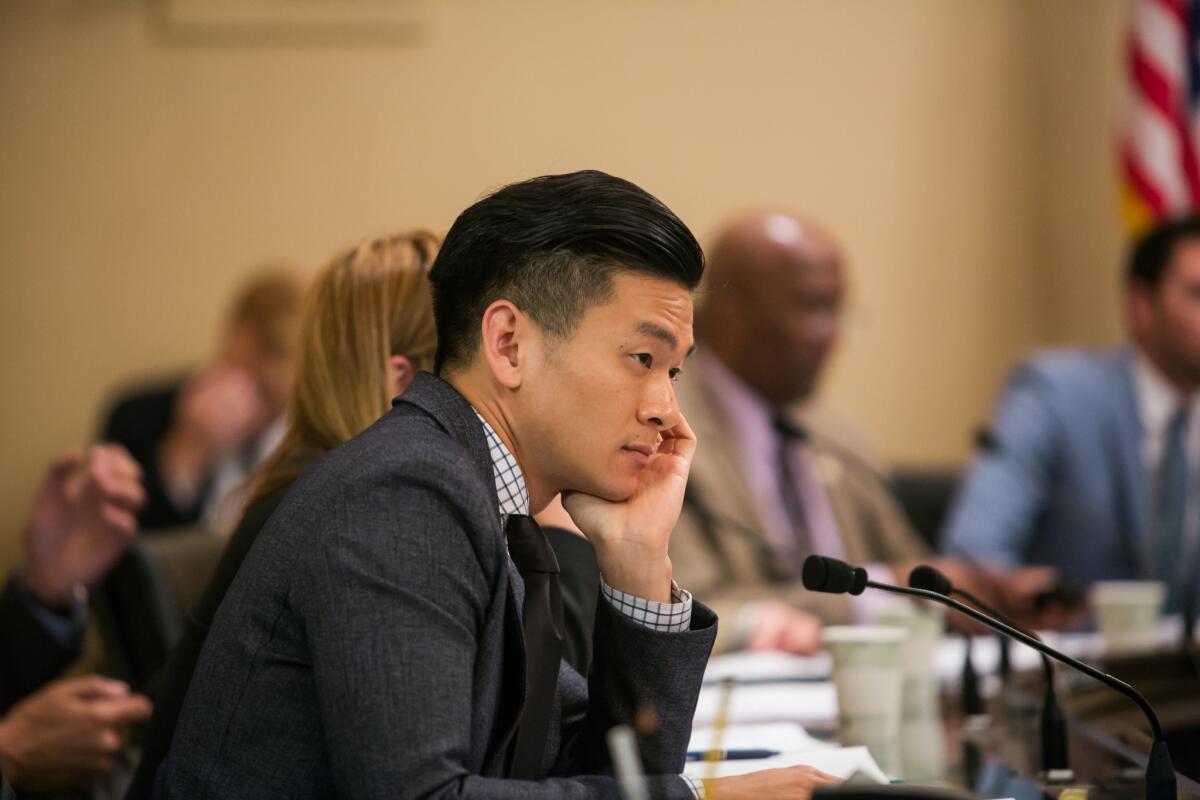The ‘tortuous and sordid history’ of a state incentive for a powerful energy upstart
Some victories in the final days of the legislative session need momentum. Others need muscle. Bloom Energy had both.
Lawmakers agreed last month to extend a vital subsidy for the Silicon Valley company, one that makes its pricey power generators more attractive to buyers such as hospitals, data centers and mega-retailers. For Bloom and its industry cohorts, the win marked the end of a hard-fought slog against powerful adversaries including utilities and labor groups.
But rival companies and some lawmakers had a different perspective: Bloom — which has on its board of directors John Doerr, a prominent venture capitalist and Democratic Party mega-donor — owes its success to the eager backing of California’s top politicians and upending the public legislative process, affording it chances most other groups don’t get.
Capitol sausage-making is rarely tidy. But the zig-zagging journey of the policy backed by Bloom marks one of the most convoluted legislative sagas of the year, prompting pointed commentary from veteran legislators.
“This bill has had a tortuous and sordid history,” Assemblyman Das Williams (D-Santa Barbara) said at an 11th-hour committee hearing on the issue on the penultimate day of the legislative session. The observation prompted knowing titters from his audience of lobbyists and lawmakers.
Bloom is no stranger to California’s political process. It reaped hundreds of millions from a state incentive created to boost technologies that let consumers generate their own electricity. After scrutiny over how those funds were handed out, it was recently overhauled to focus more on energy storage.
The company has savvy power players at the helm, including former Secretary of State Colin Powell on its board. Its most prominent financial backer, Doerr, was an economic adviser to President Obama and appeared on a 2010 episode of “60 Minutes” touting Bloom’s fuel cell technology, which produces electricity through a chemical reaction.

Doerr has poured nearly $13 million into California politics since 2001, including donating more than $600,000 to the state Democratic party and $875,000 to Gov. Jerry Brown’s 2014 committee to promote ballot measures on water and the state budget.
Bloom’s CEO, K.R. Sridhar, accompanied top lawmakers in the California delegation to the United Nations climate change conference in Paris last December and hosted Senate leader Kevin de León (D-Los Angeles) and Nancy McFadden, a top aide to Brown, at the company’s annual conference this spring.
“Bloom has just done a really good job understanding how policy affects their business,” said Steve Chadima of Advanced Energy Economy, a clean-tech trade association allied with Bloom. “Maybe they’ve just been the most aggressive when they pursue things. I think that sometimes breeds resentment.”
This year’s policy fight centered around a program meant to make fuel cells more attractive to consumers. Fuel cells produce relatively low greenhouse gas emissions, making them a cleaner energy source than traditional power plants.
Like wind and solar power consumers, sometimes fuel cell users make more electricity than they need. The excess power is transferred to the power grid and customers get credits on their utility bills through a program called net energy metering.
Bloom is not the sole fuel cell company in the state, but it is by far the most prominent. Its customers account for around 80% of the fuel cell installations in the state program; its clients are major commercial entities such as Apple and Wal-Mart. The credit can offset the product’s steep total cost — around $2 million, according to an industry analyst.
But the industry had a problem that could only be fixed in Sacramento: The net metering program was set to expire at the end of this year. Bloom, along with fellow fuel cell companies and trade groups, was getting nervous.

“It would be a great disadvantage for the customers to no longer have this incentive,” said V. John White, a lobbyist for Fuel Cell Energy, a company that produces fuel cell generators. “It would undermine the ability to make these units economically feasible.”
Top executives at the company met with senior aides to the governor early this year, appealing for a continuation.
At the same time, Bloom was backing a bill by Assemblyman Marc Levine (D-San Rafael) to extend the subsidy but also make eligible a wider array of power generators, such as gas turbines and internal combustion engines. The approach, proponents said, would boost alternative energy without favoring any one technology.
Such an effort had been proposed in past years but had been blocked by powerful opposition. Utility companies and the labor groups representing their workers saw the alternate power sources as competition; they argued the subsidies would mean existing utility ratepayers would pay higher costs. Environmentalists were also unenthusiastic, arguing the technologies were not as clean as renewable sources including wind or solar.
Staring down robust resistance and dwindling time for lawmakers to act, Bloom tried a new approach: Why not tuck the subsidy into the new state budget?
The annual state budget is accompanied by “trailer bills” that provide a roadmap on how to put the spending plan into effect. These bills are popular landing spots for unrelated policy proposals, where they are typically fast-tracked for legislative approval and go into effect immediately once signed.
Budget bills are prime territory for legislative horse-trading, where leadership in both houses and the governor haggle over priorities. The Assembly was cool to the fuel cell proposal in negotiations, while the governor and De León were in favor of the policy as a way to boost California’s clean energy goals.
The subsidy was inserted into one of the budget trailer bills in late June. The proposal was limited to fuel cells only; gone was the language making other technologies eligible.
The new proposal was the result of negotiations between the governor’s office, legislative staffers, utility companies and Bloom. Its abrupt appearance in the budget — along with a second provision to boost funds for energy storage — sparked a rare bipartisan rebellion on the Senate budget panel, where members irked by the last-minute notice refused to vote on the proposals until after the Legislature’s summer recess.
When the committee reconvened in August, Sen. Mark Leno (D-San Francisco) bemoaned the maneuvering that led to slipping the policies into the budget bill.
“I think it raises more red flags and brings more attention and so we can sometimes get a little too smart for ourselves,” Leno said.
Bloom’s leaders kept a close eye on Sacramento. In a July 5 email, Doerr wrote to Bloom board members celebrating a recent deal. It came with a rallying cry:
“Now let’s get … California legislature sorted out,” he urged.
The message came to light in a recent hack of Powell’s personal email account. A spokesperson for Powell confirmed the leak was legitimate.
Back at the Capitol, the budget play was facing a hostile reception in the Assembly. Leaders there had not agreed to it in spending plan talks with Brown and the Senate.
So that tactic was abandoned for a different one: An unrelated, dormant bill was stripped of its original content, and the fuel cell provision and subsidy for energy storage took its place.
The maneuver, known as a “gut-and-amend,” allows legislative consideration of late-developing policies. The provisions landed in a bill by Assemblyman Evan Low (D-Campbell), who said the proposal ensures that “California remains a global leader in innovation and technology.”

Low’s bill passed the Senate, but it faced speed bumps in the Assembly, where it was assigned to additional committee hearings. By then, the opposition was growing louder.
Seven companies that would have been eligible under the original proposal circulated an opposition letter that said Low’s bill “distorts markets, stifles clean energy innovation, eliminates clean energy job growth, and reduces choice for customers and ratepayers.”
One of those companies, EtaGen, had its own influential financial backer, venture capitalist Vinod Khosla, make calls in opposition. But backed by a coterie of lobbyists and trade associations, the measure persevered, clearing the Assembly and ending its long, meandering trip on Brown’s desk. A spokesperson for the governor says he intends to sign it later this month.
Bloom Energy cheered.
“We applaud our leaders in Sacramento for taking steps to extend a policy that has been successful for the last 14 years in encouraging the state’s adoption of clean energy,” a Bloom spokesperson said in a statement.
Kathryn Phillips of the Sierra Club, which opposed the proposal, said its many iterations show how the legislative process can be gamed.
“Lobbyists can be very operational,” Phillips said. “They know how to use the rules of the Legislature and, presto, change the number or form of a bill to sneak it through when people are distracted by other things. That's pretty much what has happened here.”
For those considering similar maneuvering in the future, Leno, the Senate budget chair, advised against it.
“For those who would use their wealth and connections to shortcut the legislative process, I would suggest instead to embrace it,” he said. “The benefit is greater public support and trust, which pay great dividends.”
Times staff writer John Myers contributed to this report.
Get the L.A. Times Politics newsletter
Deeply reported insights into legislation, politics and policy from Sacramento, Washington and beyond. In your inbox three times per week.
You may occasionally receive promotional content from the Los Angeles Times.








